A look into the semi-legal world of NBA highlight videos

The man behind the FreeDawkins YouTube channel works incredibly hard. Over the past 24 hours alone he’s uploaded 12 videos: including full highlights from Karl-Anthony Towns and Zach Lavine's game against the Lakers, a Wiggins/Bryant duel from the same meeting, and all 27 of Devin Booker’s points against the Raptors. On his other channel, VintageDawkins, he has freshly uploaded clips from a 2012 Curry/Leonard clash, and a near triple-double from Kevin Durant in 2014. Old games and new games, superstars and role-players, the Los Angeles Lakers and the Orlando Magic, it doesn’t matter. Every day he tirelessly documents the league, regardless of the suspect legality.
FreeDawkins is not alone. Over the past few years YouTube has been inundated with channels focusing on the seasonal industry of NBA highlights. Ximo Pierto, NBA Daily Recap, GoFactory, the list goes on and on. They have no contractual connection to the league, but in the era of democratized streaming it’s not hard for someone to cut together an eight minute package from the comfort of their own home. It’s funny to think only a couple years ago we settled for grainy, ravioli-sized clips of archive footage, and now you can literally find a full version of, say, game one of the 2001 Finals at the click of a button.
SI's 50 greatest players in NBA history
“In October 2008 I started to do basketball mixes, where you cut together highlights of one player and add music, and people actually liked those videos,” said someone who runs one of these NBA channels and who prefers to stay anonymous. “I was part of a mixmaking group called Hoops4Life, but then mixmaking died. I had a lot of channels. But the NBA people don’t like me who do these things for free and take their views. So they blocked a lot my channels and keep blocking today.”
FreeDawkins, probably the largest and most well-known basketball highlights channel, earns something between $69,000 and $1.1 million a year. That’s obviously a huge range, due to YouTube’s general obfuscation of how much their creators are actually making, but even at the lowest estimation it’s still plenty of money to make a living. Factor in the $5,200 to $83,700 he’s pulling from VintageDawkins, and it’s clear that this is more than just a hobby.
The people who run these channels don’t run from the dubious waters they’re operating in. Under every practically every single one of these videos there’s a disclaimer that states “all clips property of the NBA. No copyright infringement is intended, all videos are edited to follow the "Free Use" guideline of YouTube.” Is that accurate? Who knows, it’s tied up in a ton of copyright and free speech law that could be interpreted in dozens of different ways, but nothing can necessarily excuse the fact that we’re talking about the NBA’s product with someone else’s watermark in the bottom left corner.
“I admit it,” says the anonymous channel owner, referring to the borderline legal status. “Yeah, like I said before, NBA took a lot of my channels down. But I keep doing this thing, my new channels gets 10 to 20 thousand subscribers in three to four days! That's crazy! People support my work, my content and that is really awesome.“
Top 20 NBA players of last 20 years
It seems like the NBA could shutter all these channels pretty easily if they wanted. Their case is ironclad; people outside the Association using its telecasts for profit is strictly prohibited, that’s not exactly in the fine print. But remarkably, the Silver regime has been pretty progressive on the topic. At last year’s MIT Sloan Sports Analytics Conference, Silver was asked about the massive amount of unregulated content on YouTube.
“We’re incredibly protective of our live game rights,” said Silver. “But for the most part, highlights are marketing.”
It’s not quite an endorsement, but it’s far more democratic than, say, the NFL’s hard-nosed policy that lead to the Twitter suspension of reputable publications like Deadspin and SB Nation over copyrighted highlights. Honestly, I think the NBA’s more laissez-faire approach needs to be applauded. It’s the 21st century. Fighting piracy, especially in its least egregious forms, is a lost cause. The music and film industries gave up the ghost and embraced the consumer liberty of Spotify and Netflix, maybe the NBA is doing the smart thing by turning a (mostly) blind eye.
“People need these channels,” says the anonymous owner. “Sometimes people get home after work and don't want to watch full games, they need their favorite player’s performance video. So they search it on YouTube and they find my videos. Maybe they don't like NBA channel's content and prefer full highlights. I'm okay with that, I enjoy editing, it's my life. I like doing this for people, and when I get support from them it motivates me even more.”
Power ranking all 30 NBA floor designs
30. Los Angeles Clippers
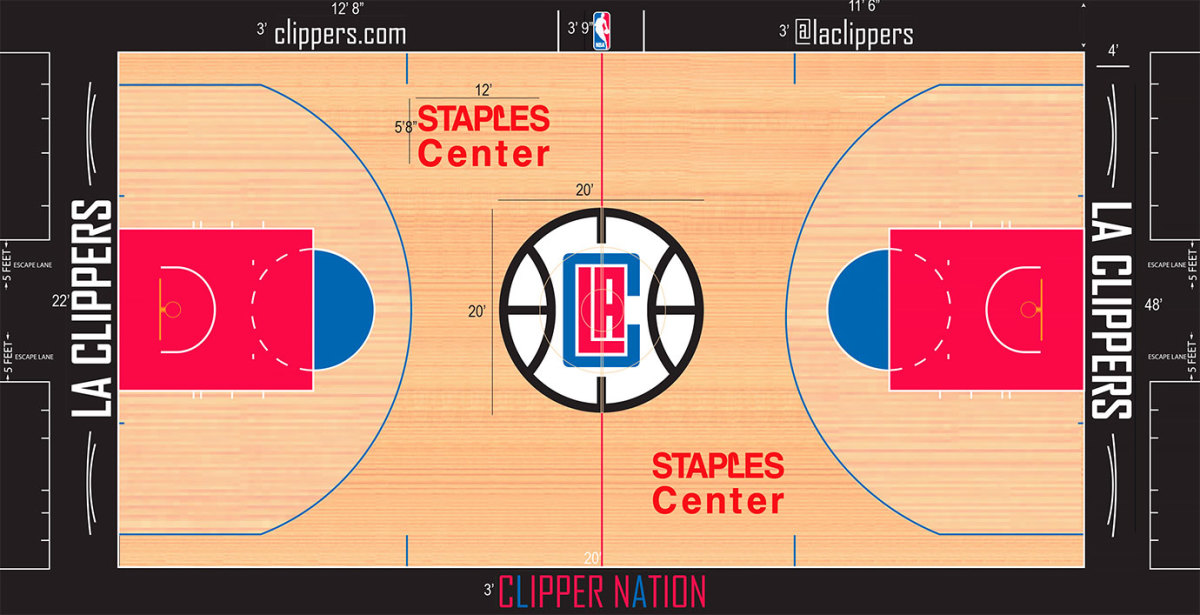
Much has already been said about the horrific logo the team adopted last summer. But the Clippers made matters worse and slapped the logo at center court and used odd “nautical” lines to help adorn the baseline.
29. Oklahoma City
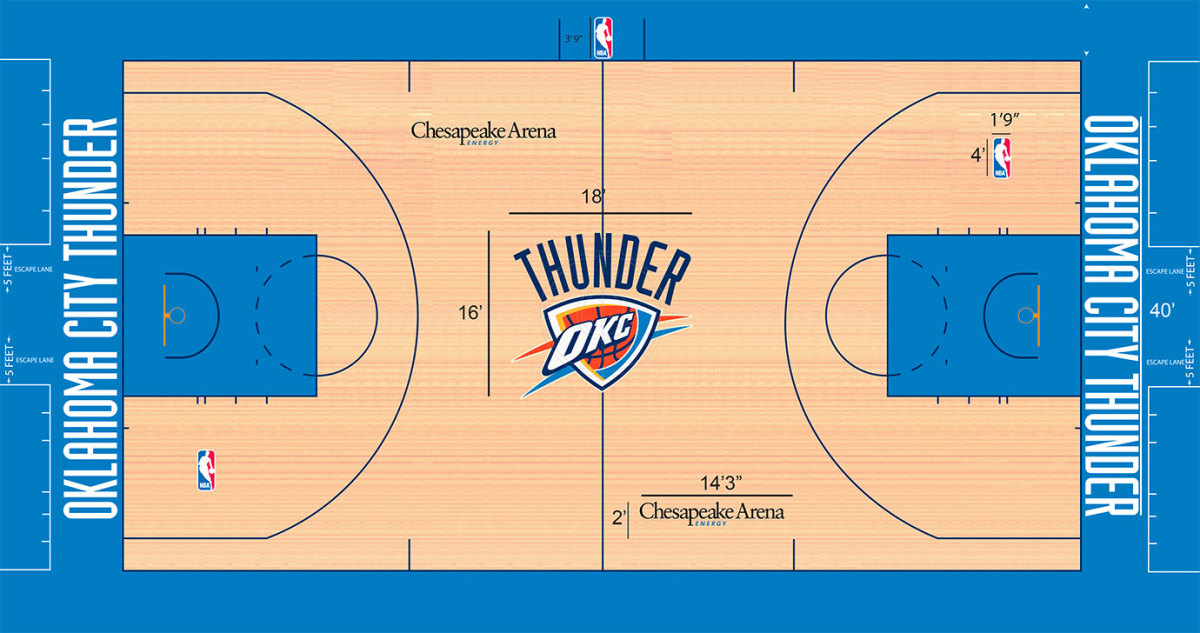
It doesn’t get much more drab than the floor in Oklahoma City. The muted blue that fills the key and out of bounds baseline and apron areas lacks intrigue, especially when paired with the light wood stain.
28. Minnesota
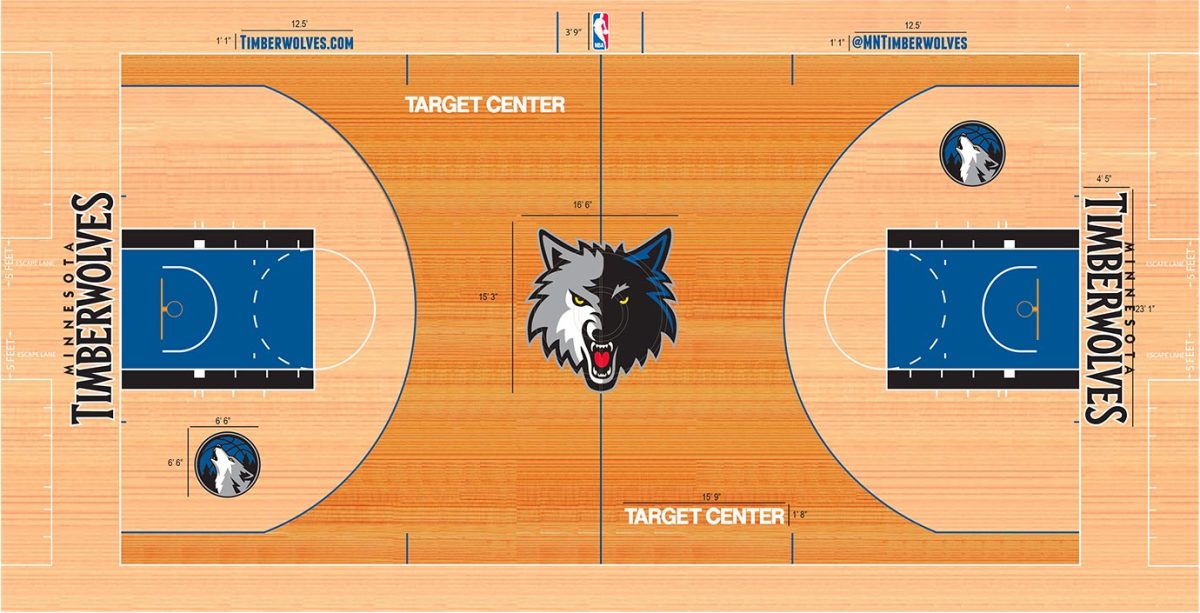
The mid-2000s rise of the two-tone stain lives on in all its contrast in Minnesota. The Timberwolves maintain a dark stain outside the 3-point lines and a light stain inside. The difference is so drastic that they don’t play well with each other. Adding in the light stain on the baseline and apron areas doesn’t help.
27. Phoenix
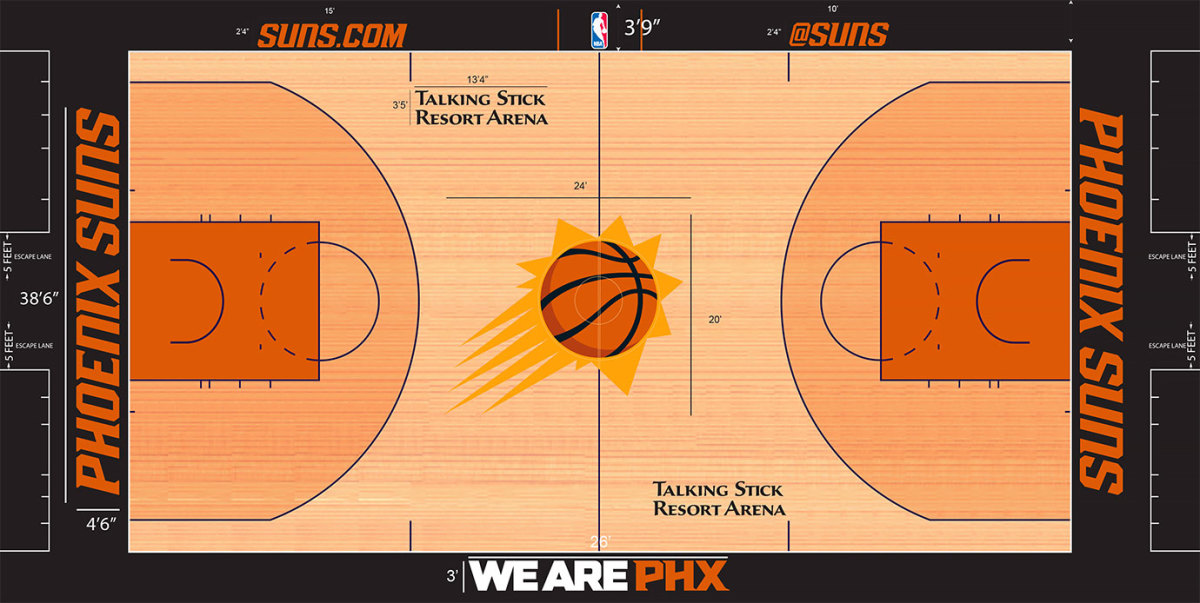
The sunburst logo returned to center court this season after a decade of absence, but eliminated the “Suns” ambigram, which could be read correctly from either side. Along with it came a reappearance of purple lines and a two-toned stain with lighter stain outside the three-point arc and darker inside.
26. Utah
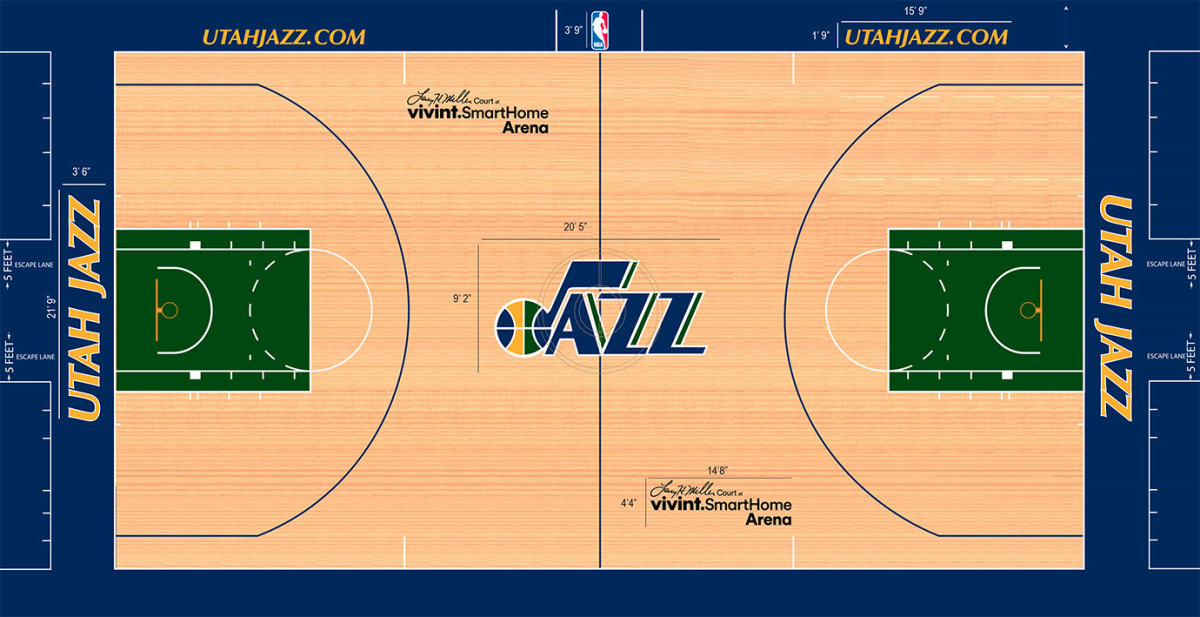
The Jazz have long felt like a team in a permanent identity crisis. At least for now, green is the color du jour. But that deep green clashes slightly with the blue baseline and apron, a simple strike against what is otherwise a traditional design.
25. Dallas
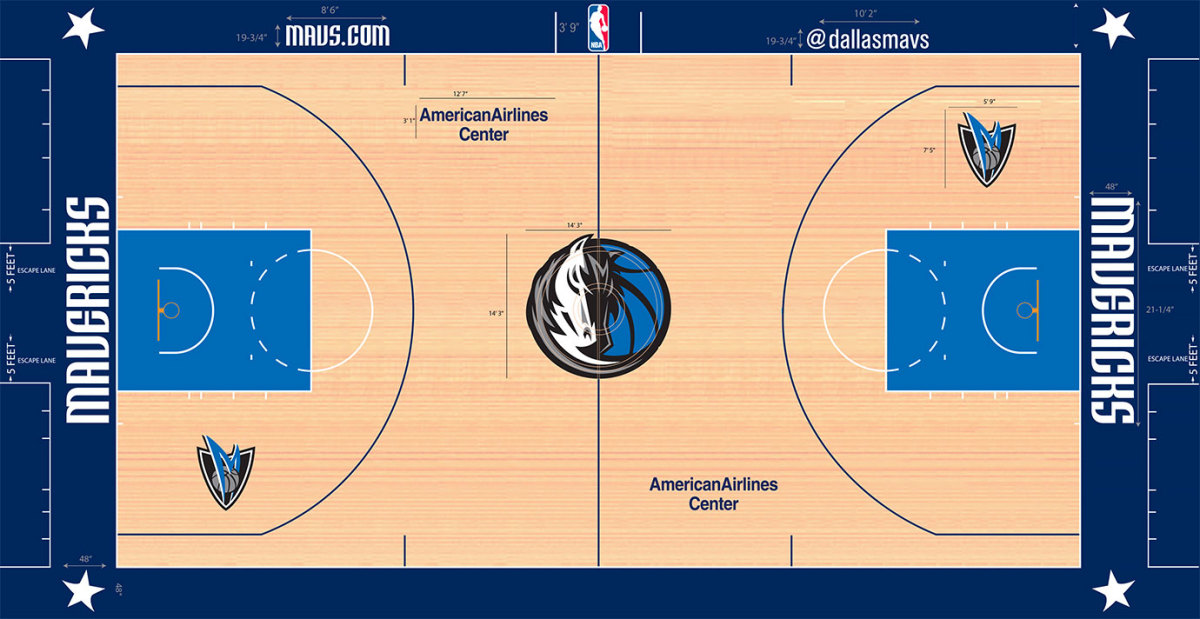
We get a consistent light stain—which is said to show contrast of the ball more clearly, hence it serves the common choice throughout the league—with dark blue out of bounds and light blue in the key. The Mavs have a fairly basic, somewhat boring floor design.
24. Houston
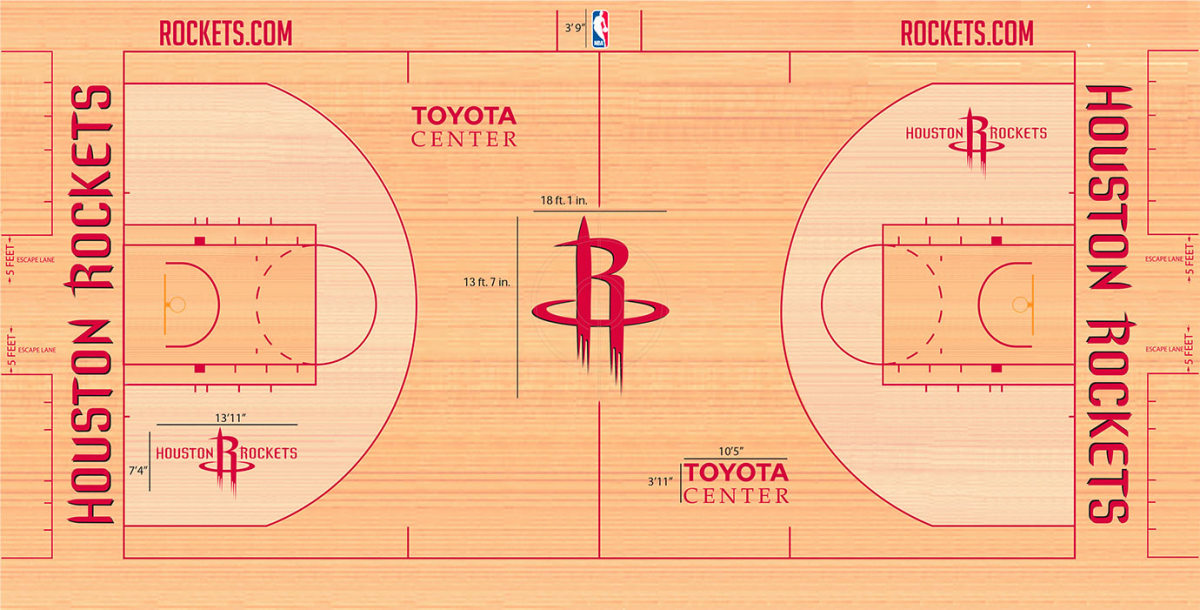
Houston has an aversion to paint. The Rockets logo in the center—stretching over 18 feet tall—offers a bit of something different from the purely circular logos found aplenty across the NBA. Points for originality, though, as the Rockets serve as the only NBA team without an area of solid paint at least out of bounds or in the key.
23. Washington
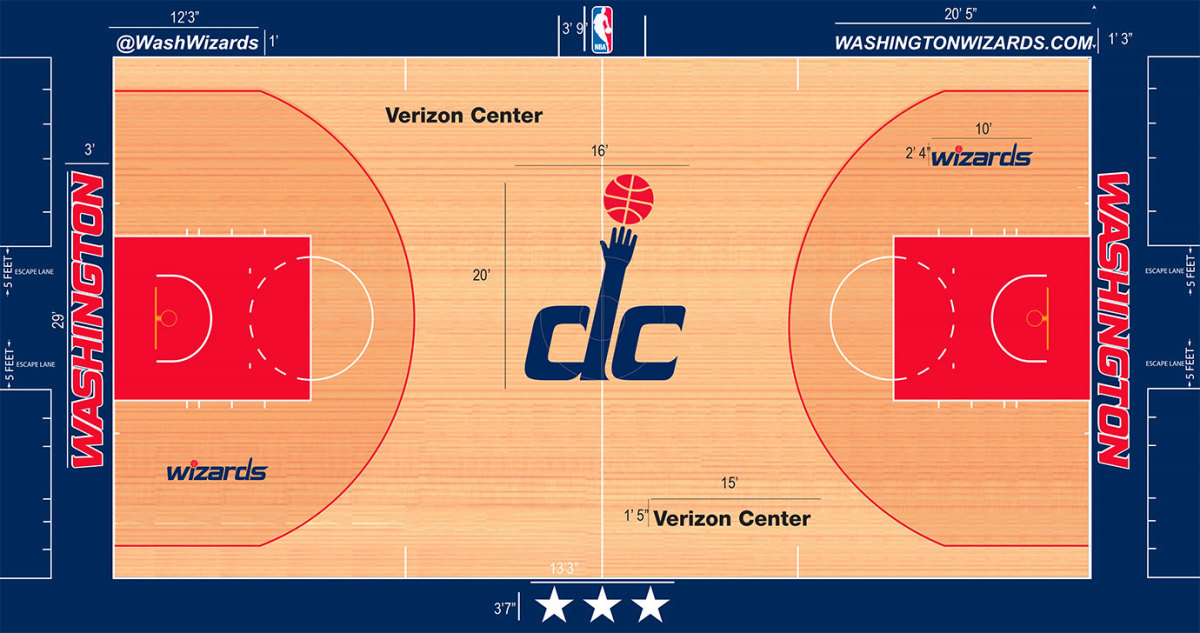
The Wizards have messed with their floor multiple times over the years and the latest iteration plays up the “DC” hand/ball logo in dramatic fashion at center court at 20 feet tall.
22. Chicago
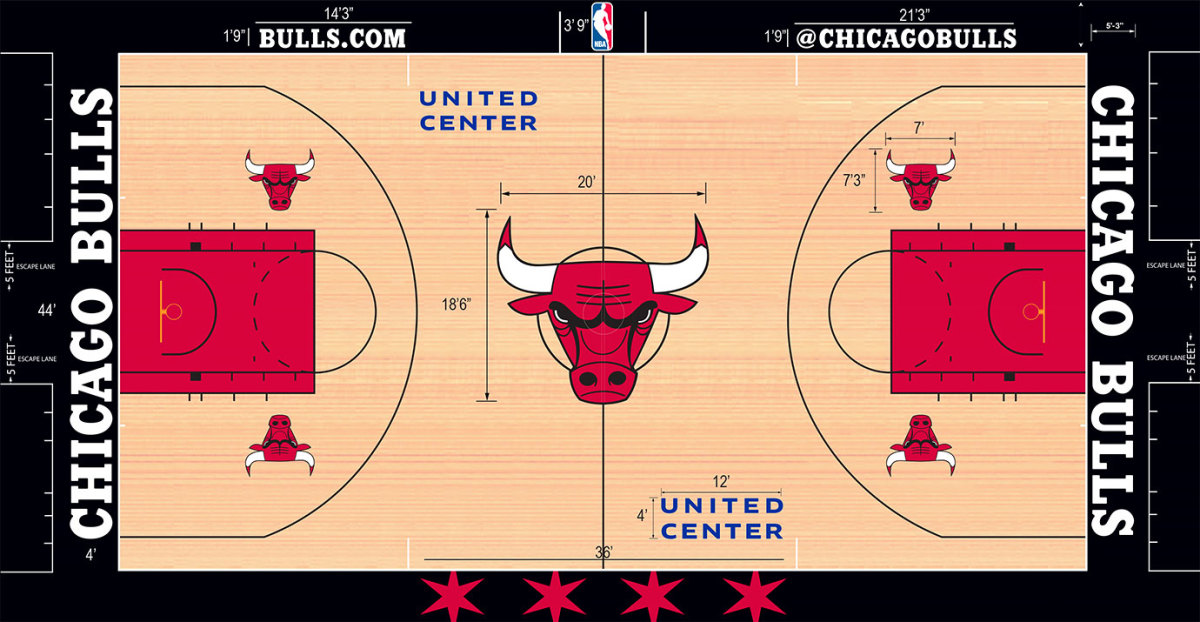
While many folks clamor for the raging bull logo at center court, upsizing the logo by roughly 75% this season has given us all the bull we can handle. And then, as the only team in the league to do so, they place four more small bull logos on the court with two inside each three-point arc.
21. Detroit
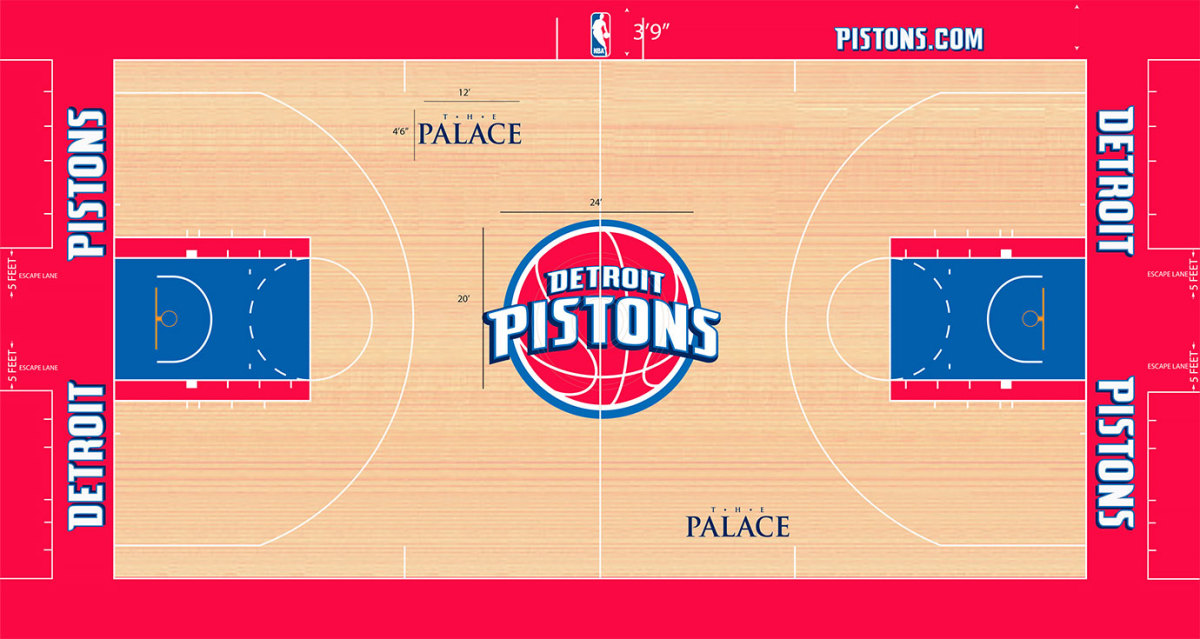
The Pistons feature one of the largest logos in the league. And those logo colors play throughout the floor, with a blue key outlined in red and a red out of bounds area.
20. Miami
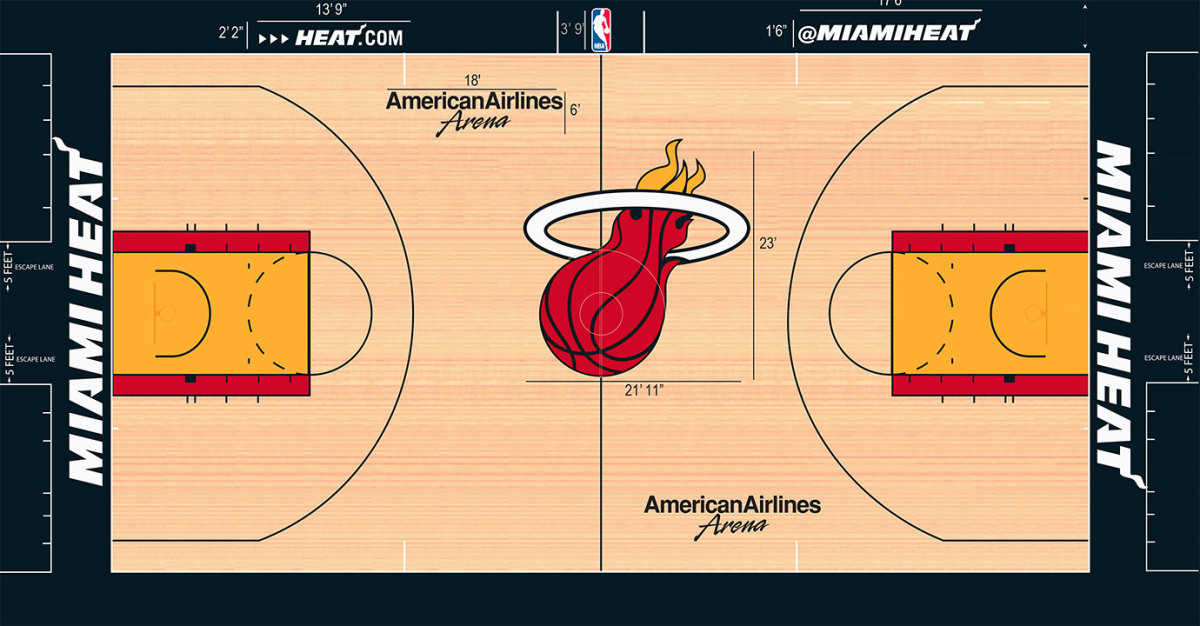
This is one of the few times where the two-toned key paint seems to work. With the flaming ball logo in yellow and red at center court—one of the largest in the league, at 23 feet tall—over top a consistent light stain, the yellow paint with the red outline matches.
19. Memphis
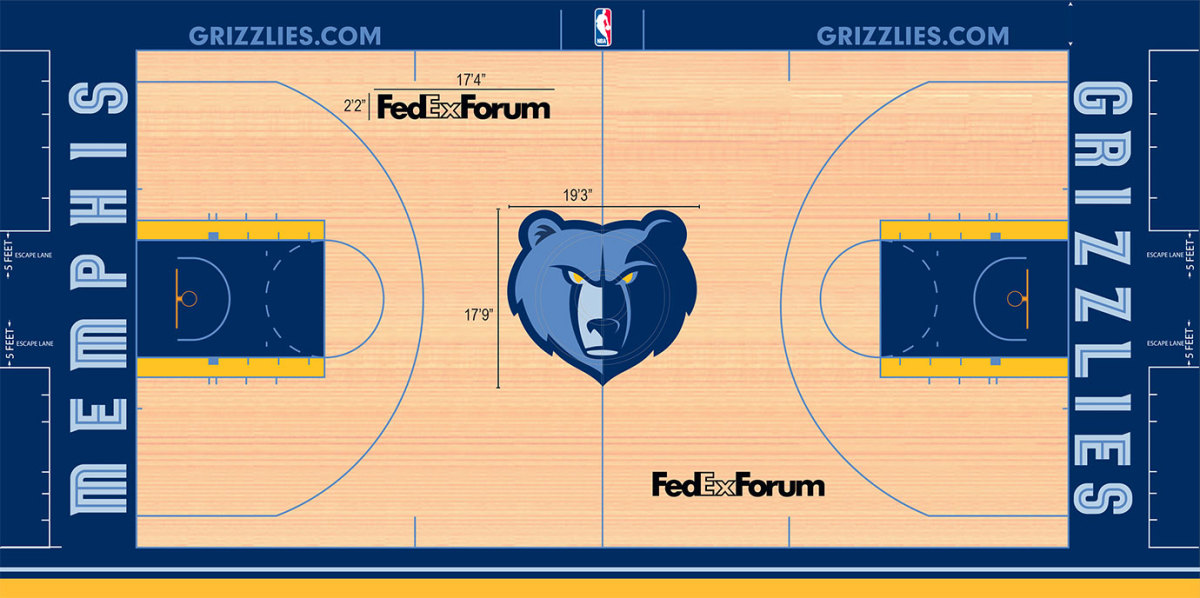
Dark blue fills the paint, extends to the baseline and apron and even matches the Grizzlies logo at center court. A touch of yellow in the key’s box area helps offset the blue and using light blue for the fashionable font on the baseline and for the lines on the floor offer a nice touch.
18. New York
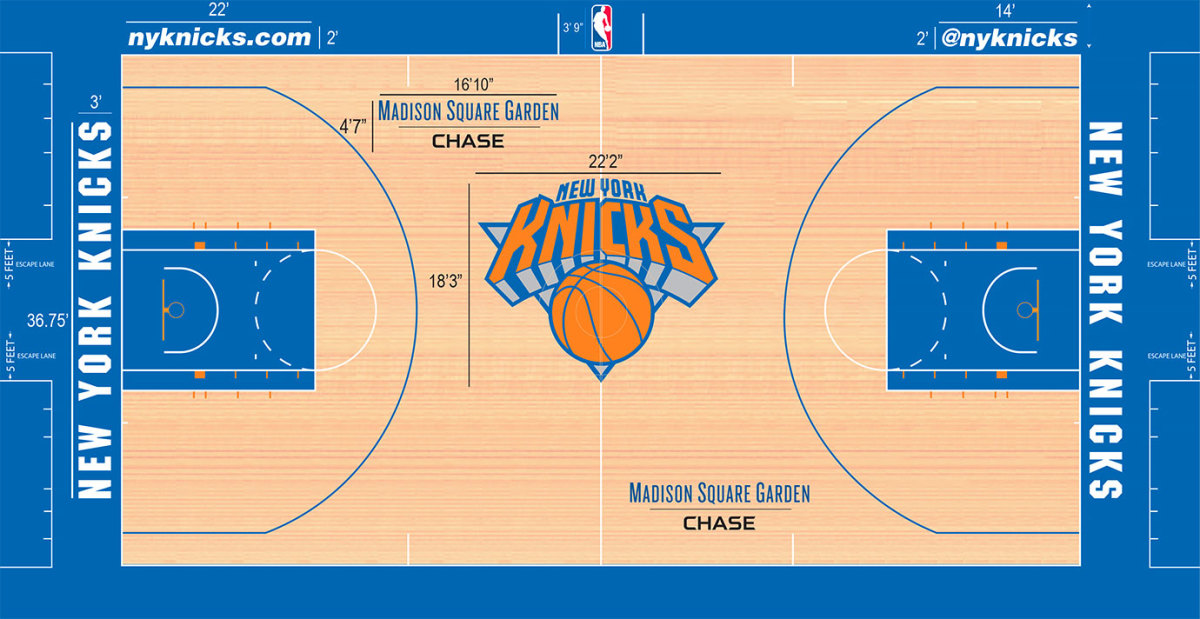
The Knicks have returned to blue in the paint. The orange-heavy Knicks logo at center doesn’t look as muted any longer by adding blue back into the paint, improving this clean Madison Square Garden look.
17. Indiana
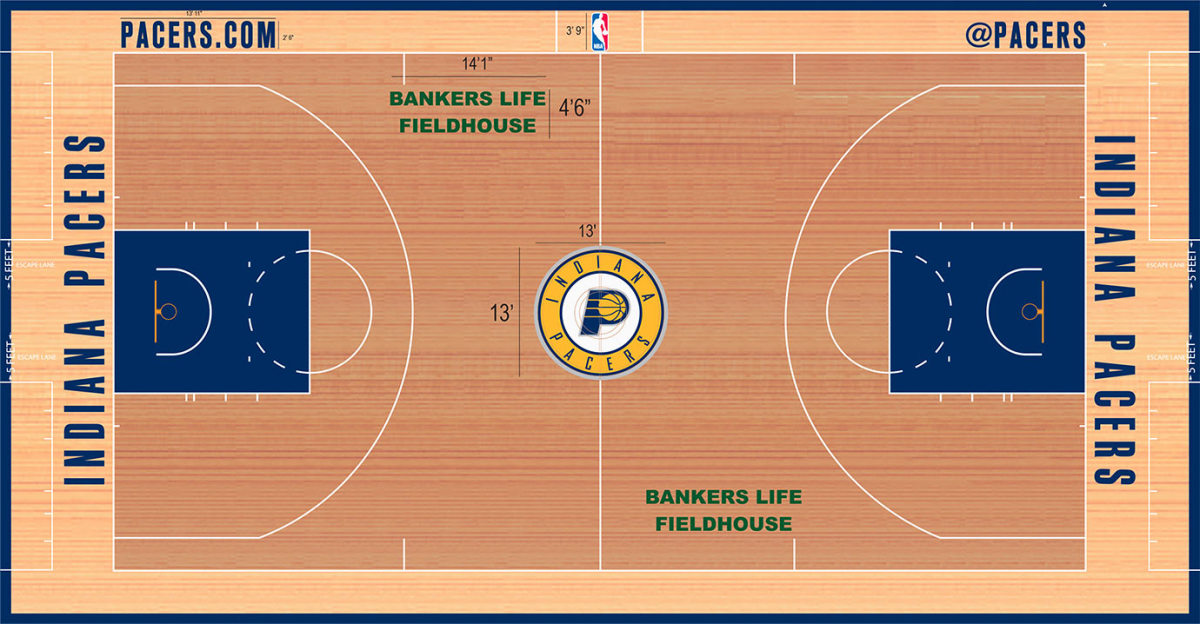
The floor is clean and classic, just what you’d expect from Indiana. The 13 by 13 logo is one of the smallest in the league, and without any other markings—other than the arena name—this is one of the least adorned floors in the NBA.
16. Cleveland
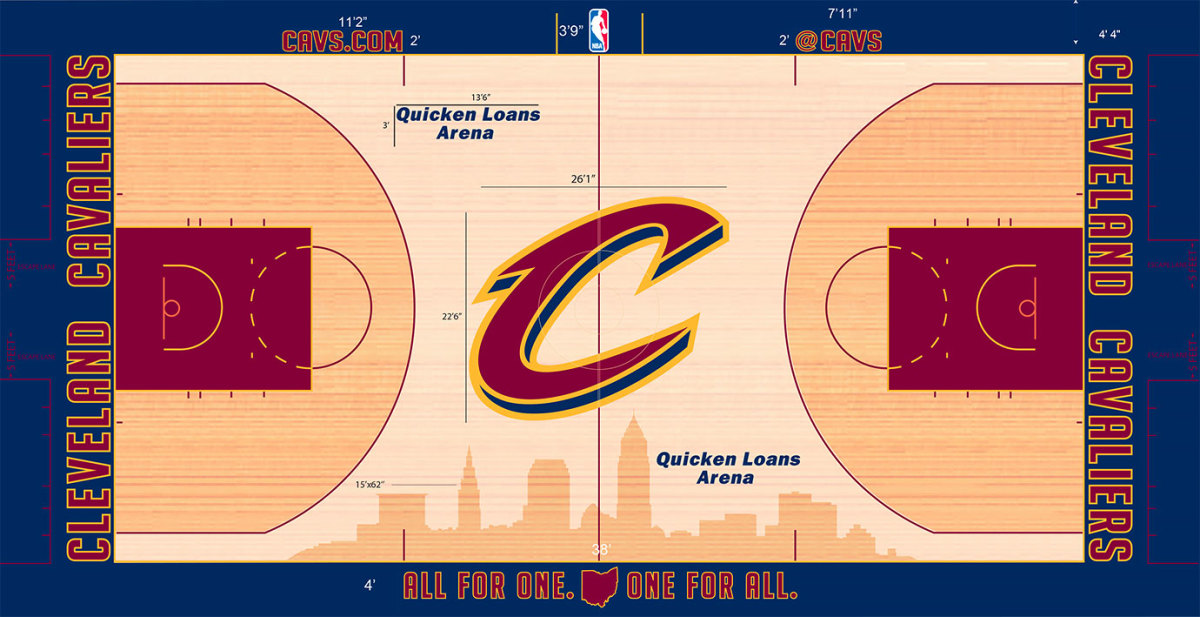
The oversized “C” logo in the middle may delight some, but may prove gaudy to others. At over 26 feet wide and over 22 feet tall, this C signifies enormity in the NBA, the largest width of any center logo. The cityscape in stain stretching 62 feet along one side creates yet another oversized feature.
15. Orlando
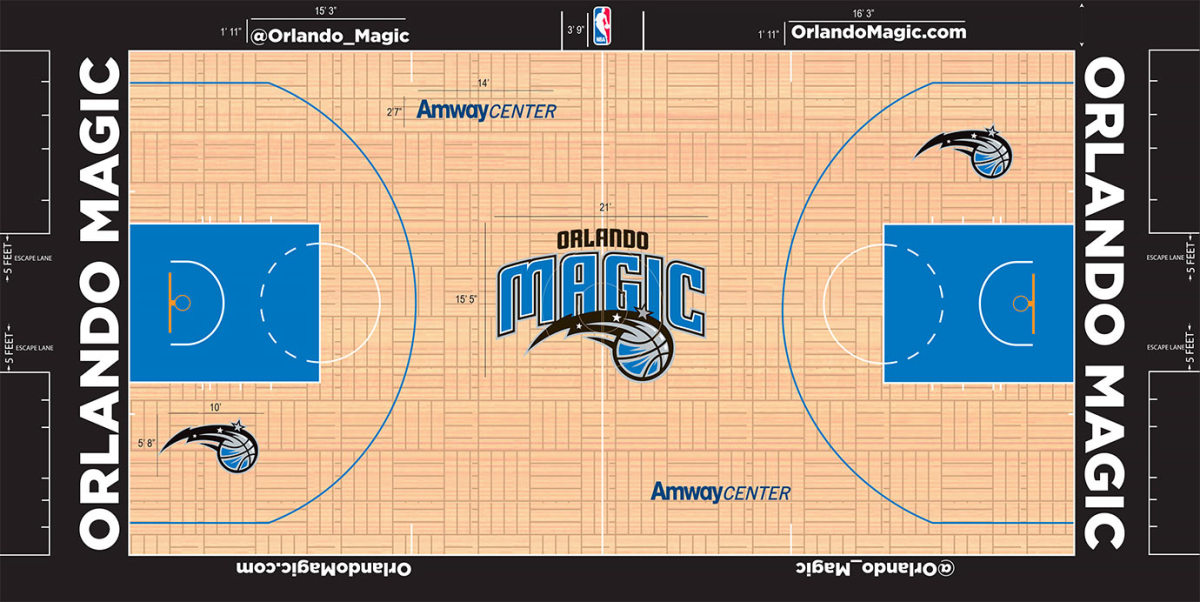
As only one of two teams going with a true parquet look, Orlando pulls it off well. The blue and black merge solidly with blue in the key and black framing the court as the color out of bounds.
14. Sacramento
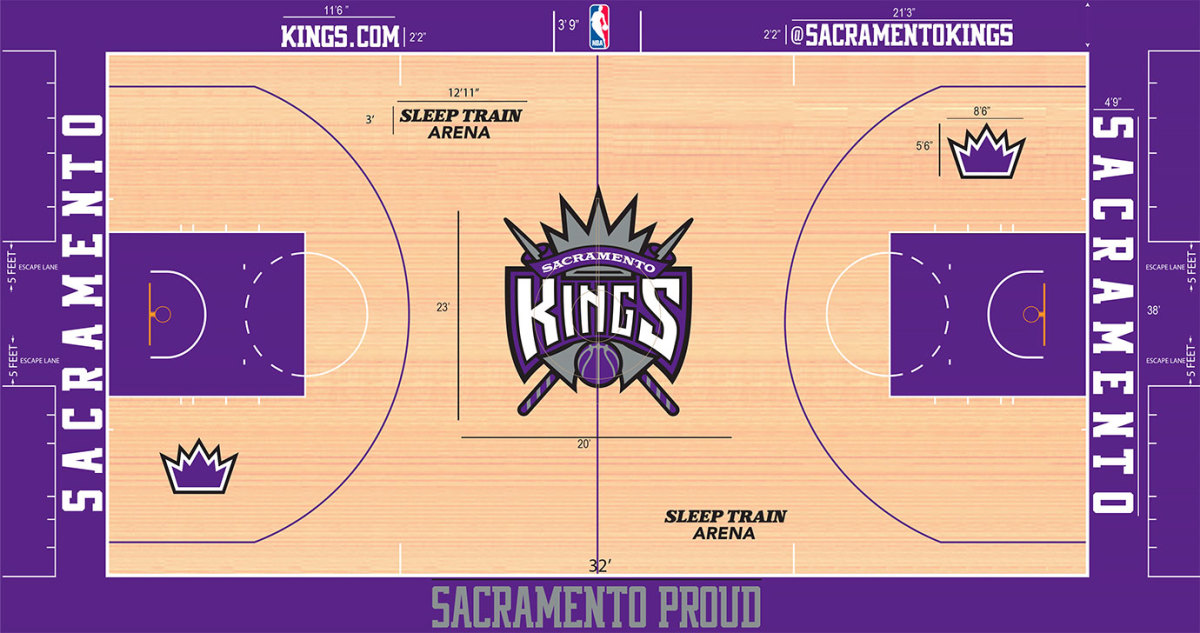
Let’s hope you enjoy purple, because you get plenty of it in Sacramento, where “Sacramento Proud” runs along the sideline apron. The best touch comes with the purple crowns, one inside each three-point arc.
13. San Antonio
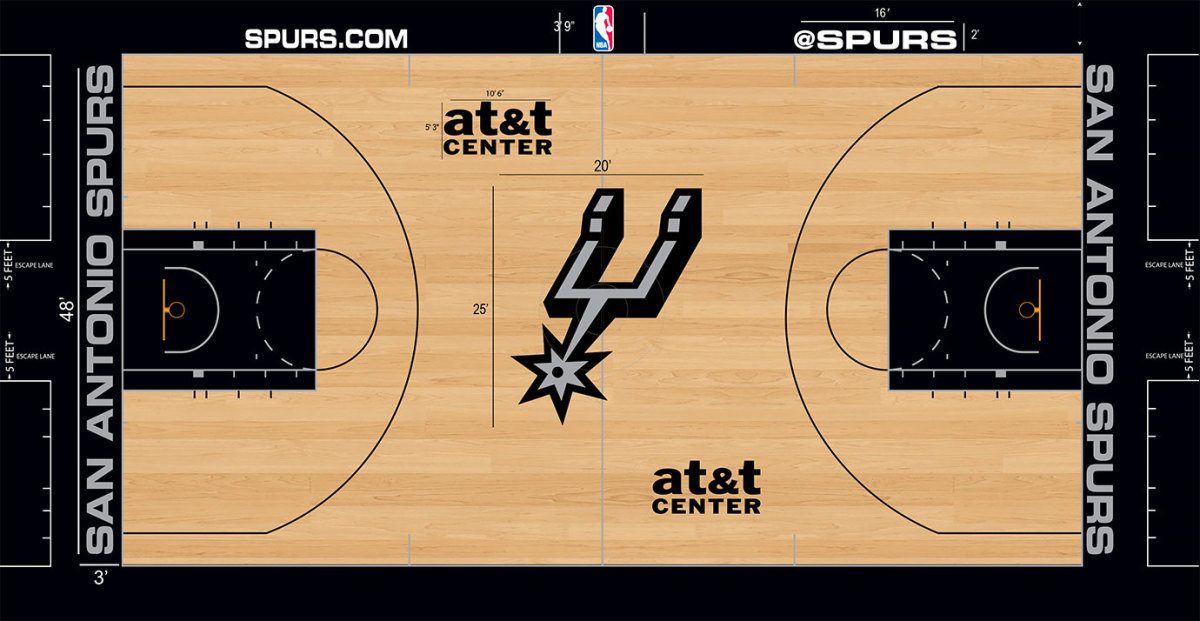
The court remains simple and classic, just like the team. The recent change to a giant spur logo in the middle—the spur stretches 25 feet tall and 20 feet wide, the largest height the league—proves a nice upgrade.
12. Portland
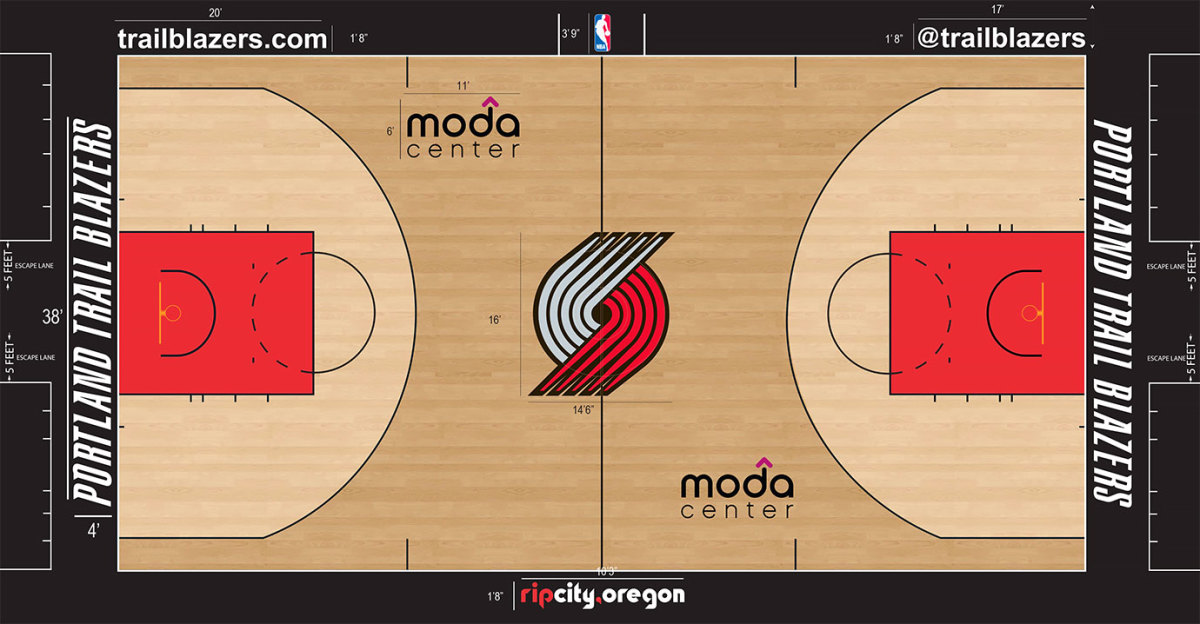
While we don’t love the dark stain outside the three-point arc and the light stain inside, it seems to work in Portland, maybe because the medium-sized pinwheel logo going only 16 feet tall doesn’t overwhelm. Plus, we love “Rip City, Oregon” on the apron.
11. New Orleans
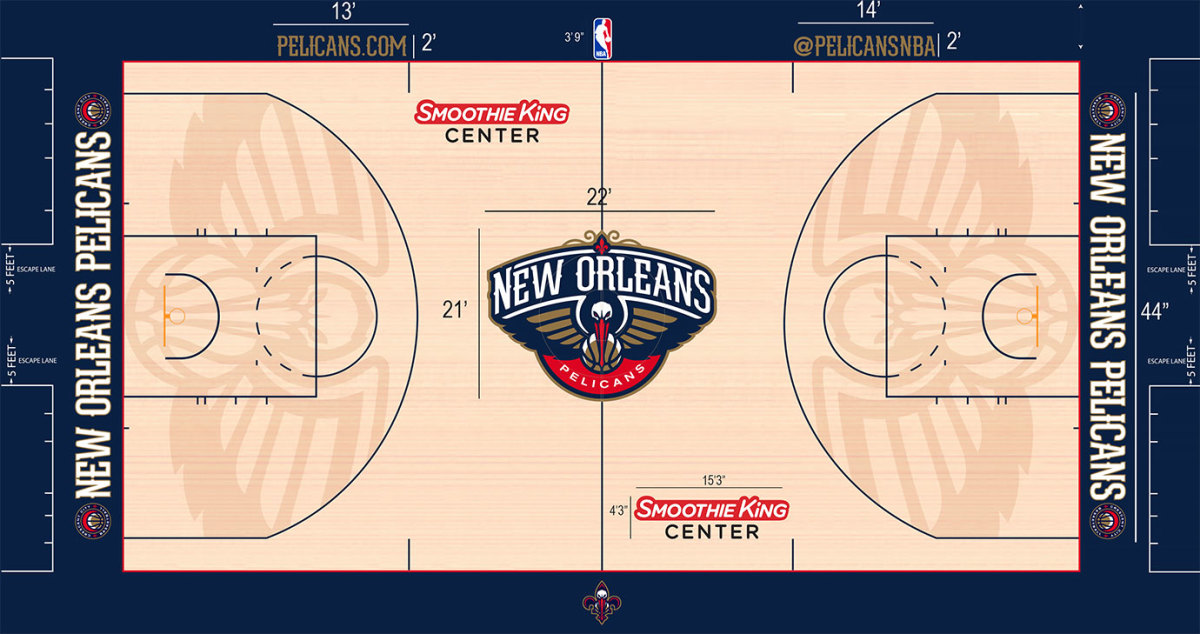
Long live the pelican. In one of the most ambitious uses of originality in stain across the NBA, New Orleans gave us pelican wings filling the entirety of the areas inside the three-point arc.
10. Philadelphia
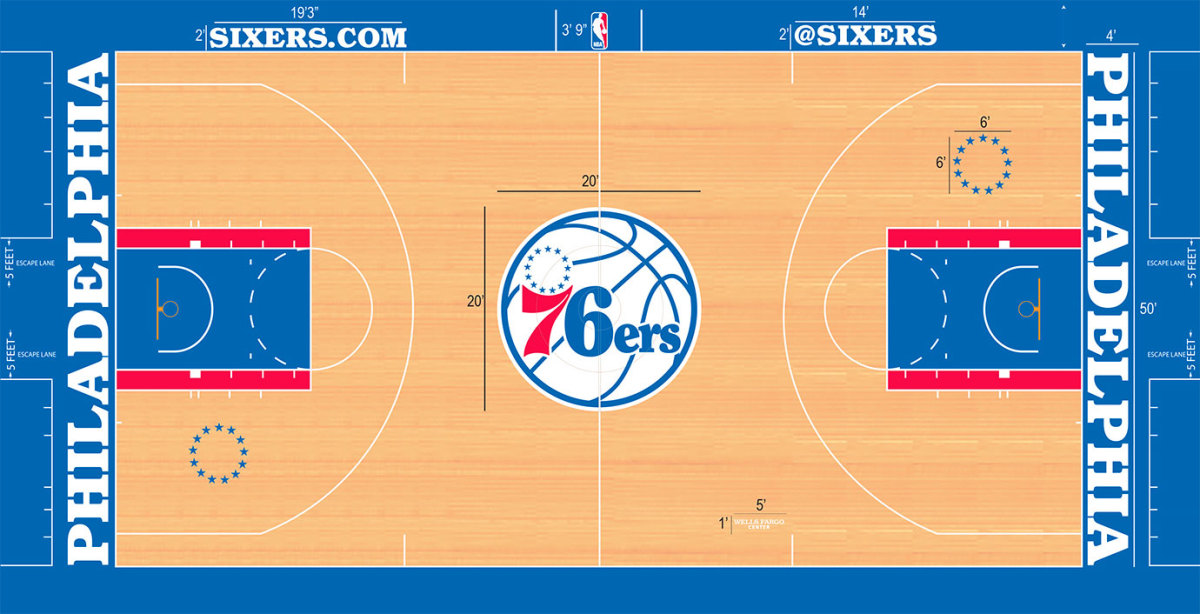
The 76ers don’t disappoint traditionalists with an old-school logo in the center of the court on a light stain. They mix a blue key with a red outline, blue baseline and apron and white lettering to more subtly and tastefully give us a red, white and blue motif.
9. Atlanta
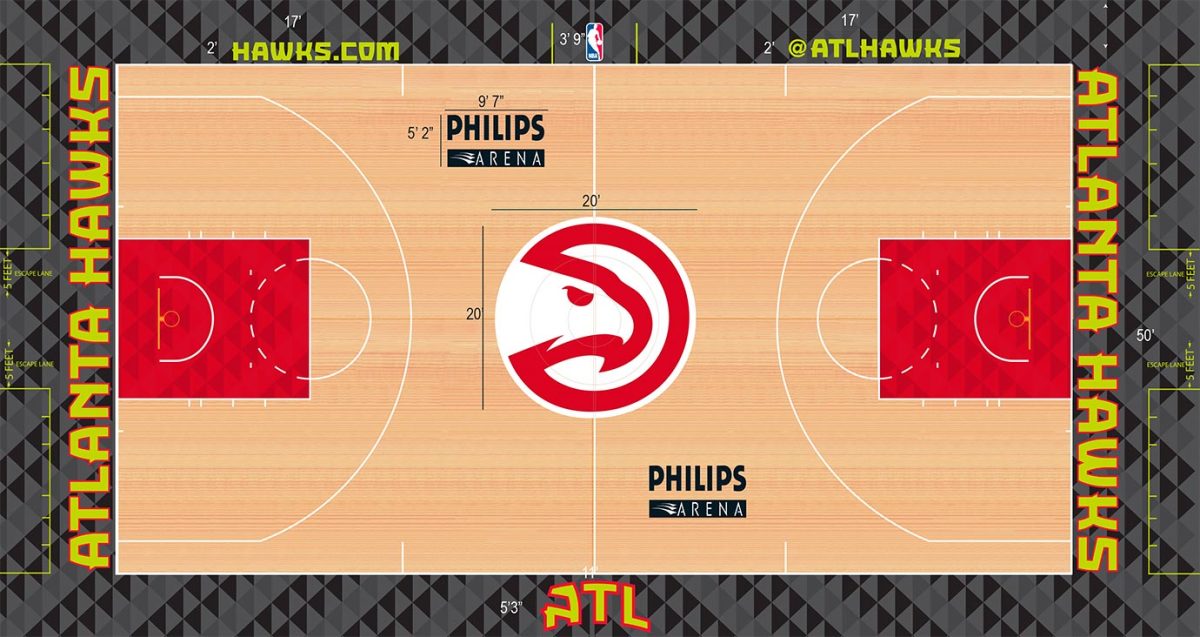
The PacMan logo at center court puts an updated spin on their classic logo. The rest of the progressive look is formed by three shades of red in a triangulated pattern inside the key, three black shades in the same pattern on the apron and the modern neon yellow across the apron and baseline.
8. Denver
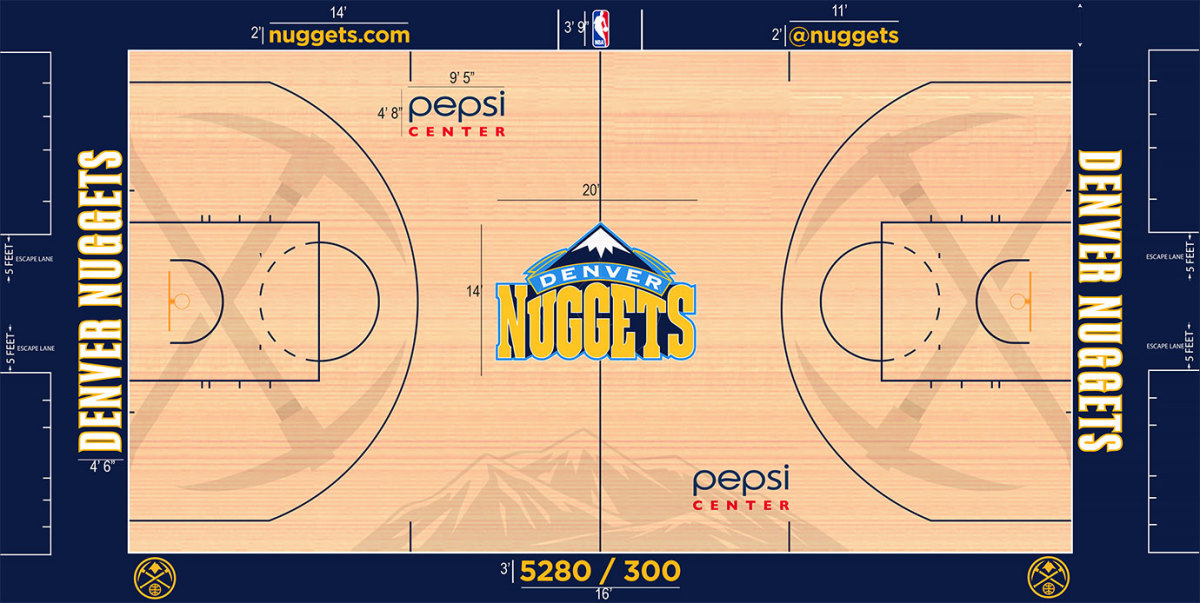
The only floor to use this much stain for art, the Nuggets feature crossing pick-axes in a darker stain inside each three-point arc and a mountain scene in stain on the sideline.
7. Charlotte
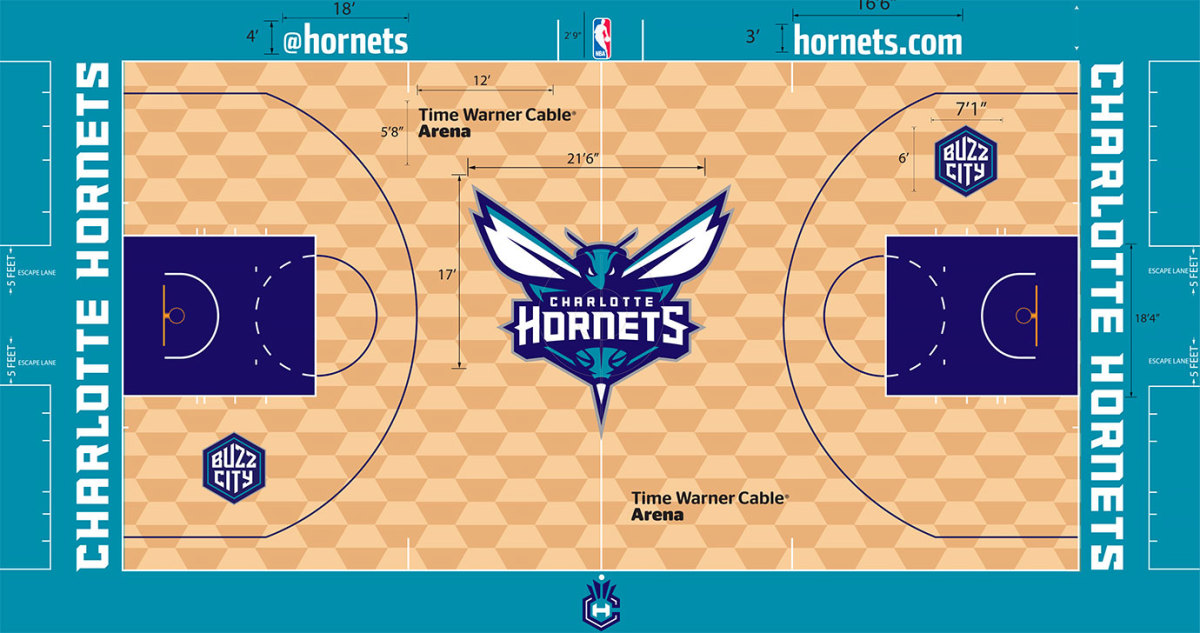
Oh, the genius of the honeycomb. Using stain on the maple, the Hornets created a complete honeycomb pattern in contrasting light and dark across the entirety of the floor.
6. Los Angeles Lakers
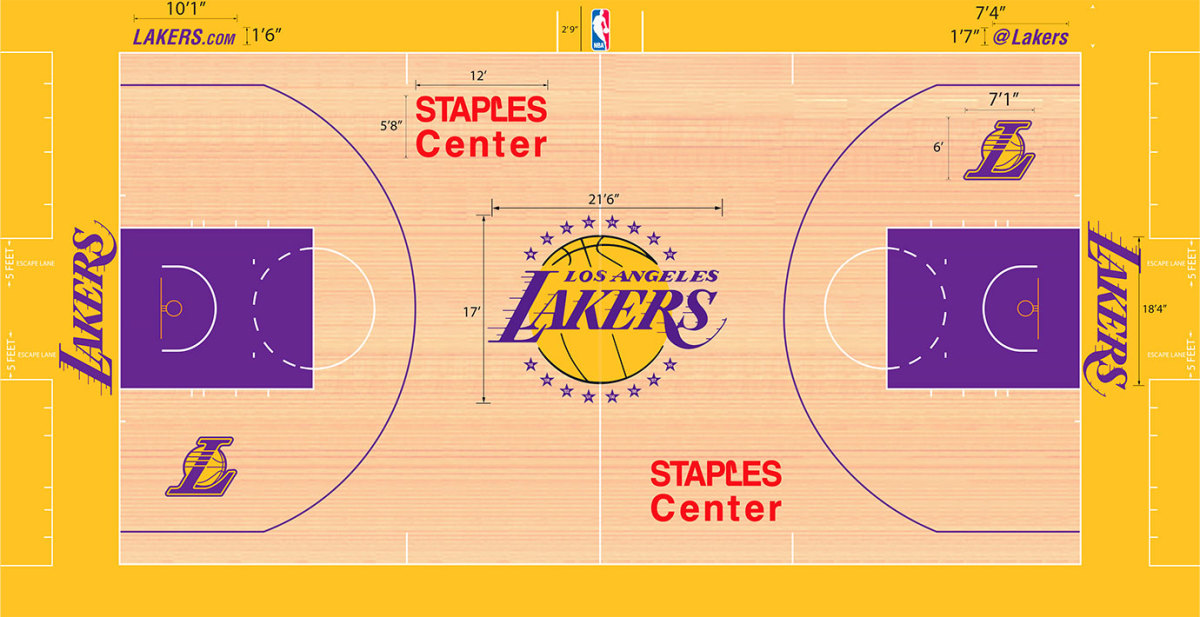
The Lakers have embraced a unique color scheme, using a light stain to show off a yellow (or is it gold?) and purple—also known as “Forum Blue”—key and purple three-point line. A full Lakers logo at the center remains traditional.
5. Toronto
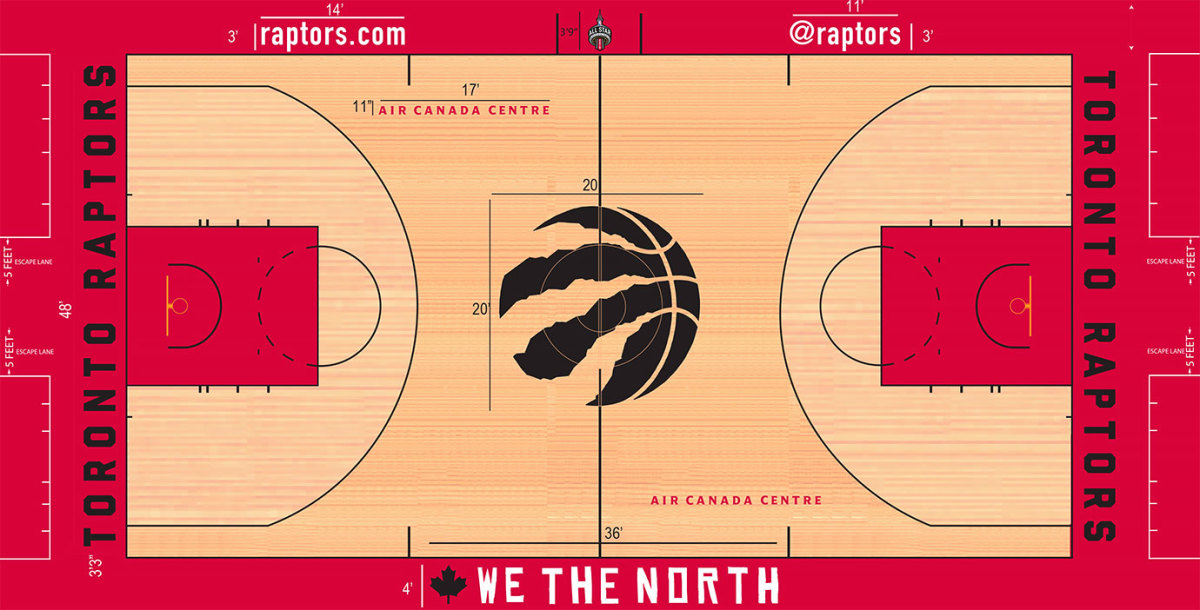
We the North. Adding the team’s well-known phrase, with a maple leaf, mind you, to the apron was a nice touch on a court heavily improved by recent upgrades in color and logo choice. The use of an all-black, claw-ripping logo in the center truly gives Toronto a tastefully done and original logo that doesn’t detract from the brand of the team.
4. Golden State
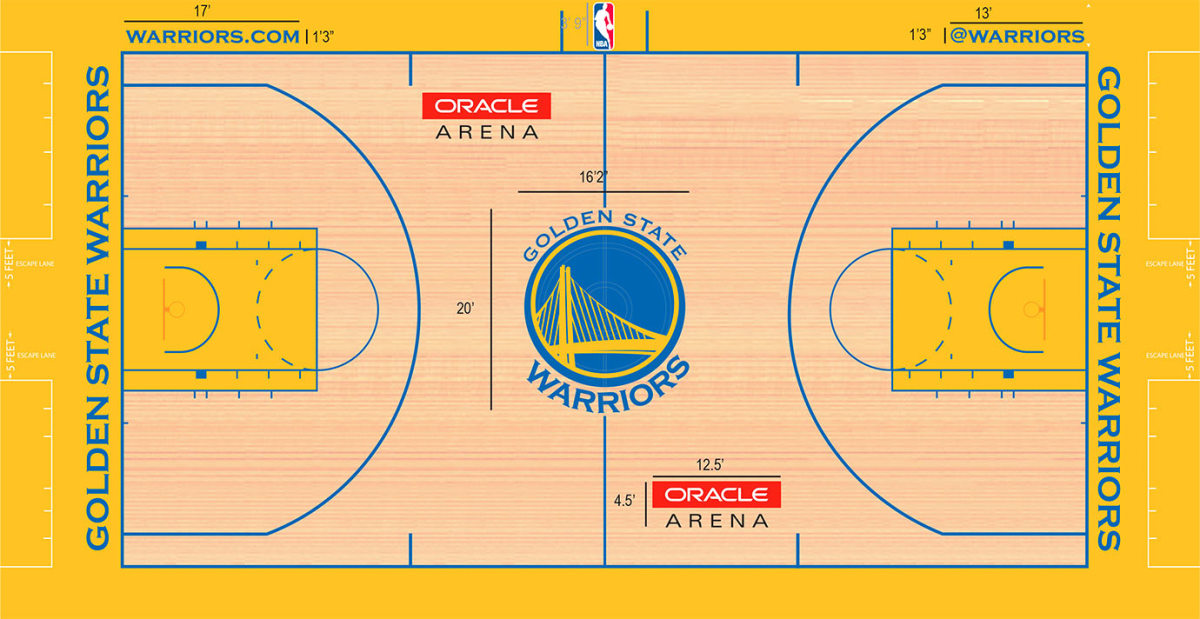
The official California golden yellow shines on the court, in the frame and in the key. The use of Warriors royal blue for all lines helps build on the team branding and color scheme. But what really propels the Golden State court to the upper echelons of the NBA is one of the best logos in all of the NBA—complete with its heavy use of blue that stands well on the light stain and contrasts the golden yellow. The Warriors can switch to “The City” logo at the center on a whim, giving a classic look or a true old-school vibe whenever needed.
3. Boston
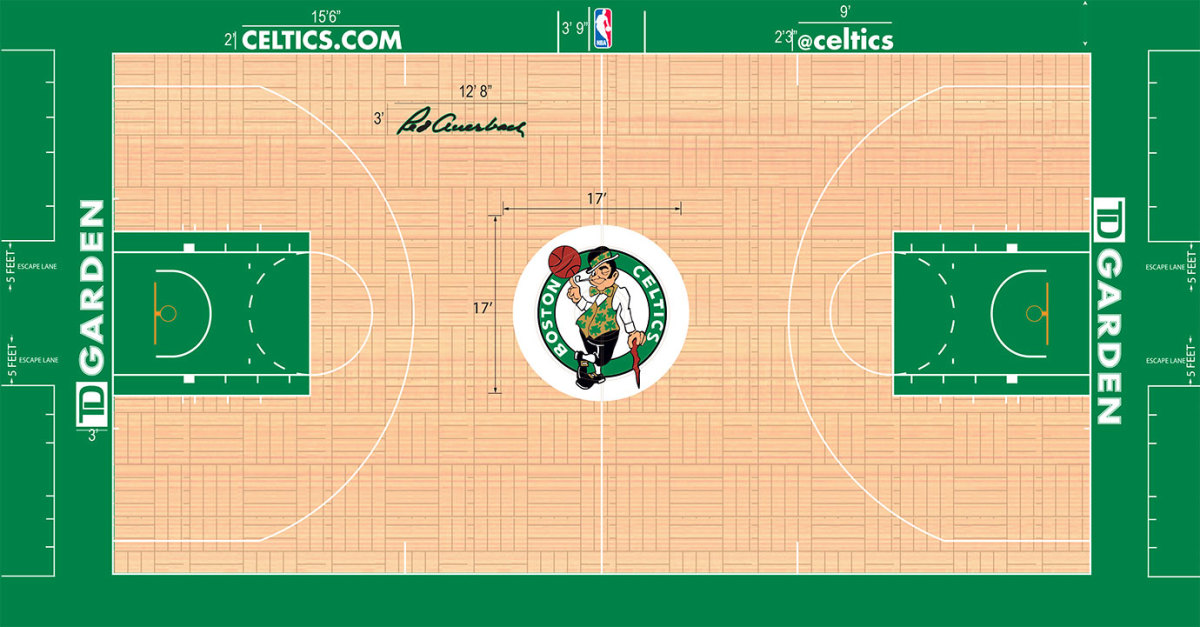
The power of parquet comes with the tradition of Boston. While they have a brand new red oak floor, the Celtics haven’t changed the parquet pattern in one of the most classic and clean looks in the league. The court has one key element: Red Auerbach’s signature. Traditional. Classic. Original.
2. Milwaukee
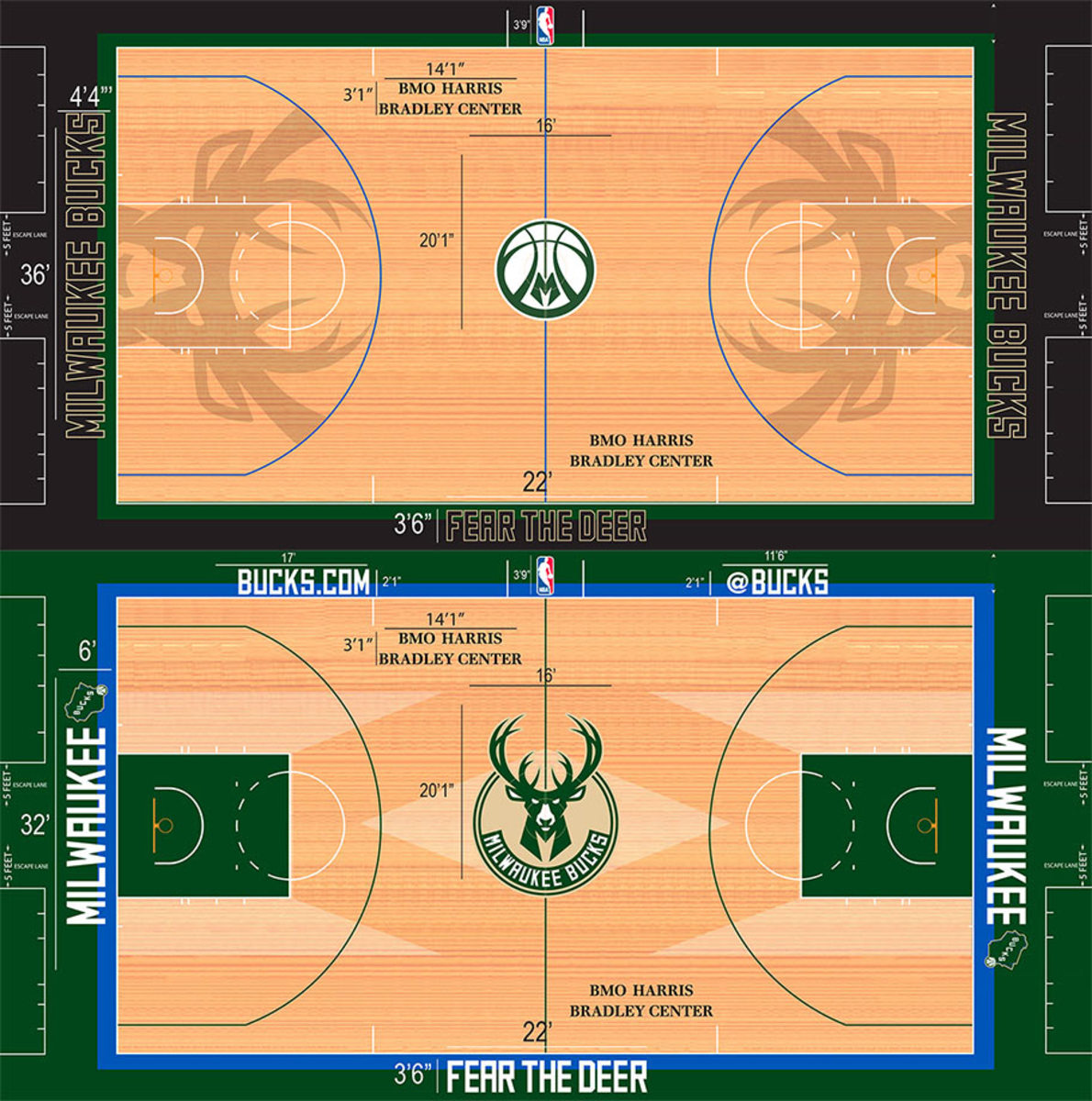
The Bucks have two fully original court designs. As a play on the team’s 1970s Robert Indiana-designed MECCA Arena floor, the Bucks use dark stain to recreate the giant, colorful horizontal M on the floor. The alternate floor offers us a smaller alternate logo in the middle, removes the MECCA design and replaces it with the sweetest stain-drawn deer antlers you’ll ever see inside a three-point arc.
1. Brooklyn
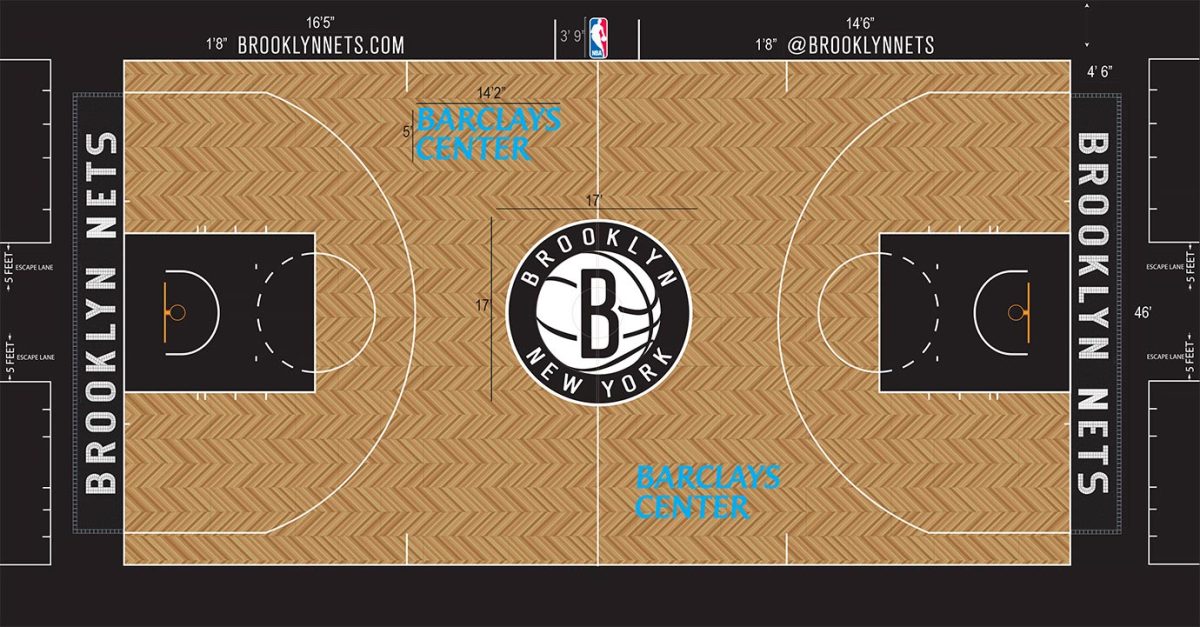
It is one thing to be different, but it is quite another to do different well. The black and white doesn’t disappoint, with a black frame and black key merging with white lines and the black-and-white center logo in a modest size. Brooklyn, using differing grades of maple positioned angularly, created a herringbone pattern across the whole of the floor. The 2015 addition topped it all off by using “subway art” to create the lettering of “Brooklyn Nets” on each baseline. Perfect originality.
Personally? I’m thrilled that these channels exist. Yeah it makes me a little queasy that people are making auxiliary profits from trademarks that don’t belong to them, but still, the only thing that separates FreeDawkins from ESPN is a licensing deal. These people love basketball, and they’re building a massive archive for the sport with each and every game. Years from now I’m going to remember some random Jamal Crawford run, and I’ll be able to pull it up on my computer in about five seconds. What a great moment to be a fan! We know deep down that we shouldn’t feel guilty for watching transcendent basketball on YouTube, and right now, it seems like the NBA is inclined to agree.
